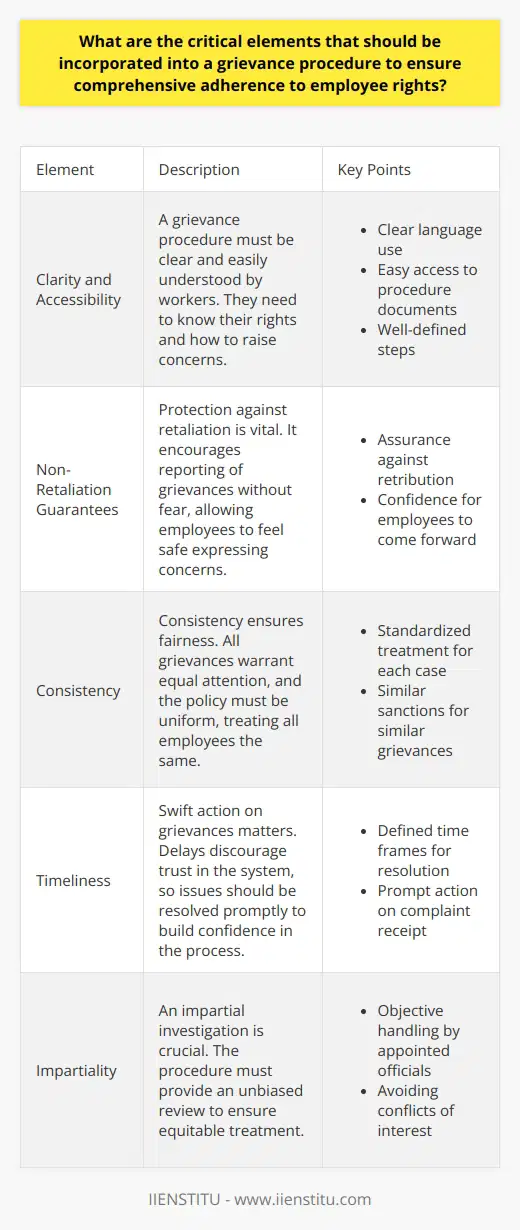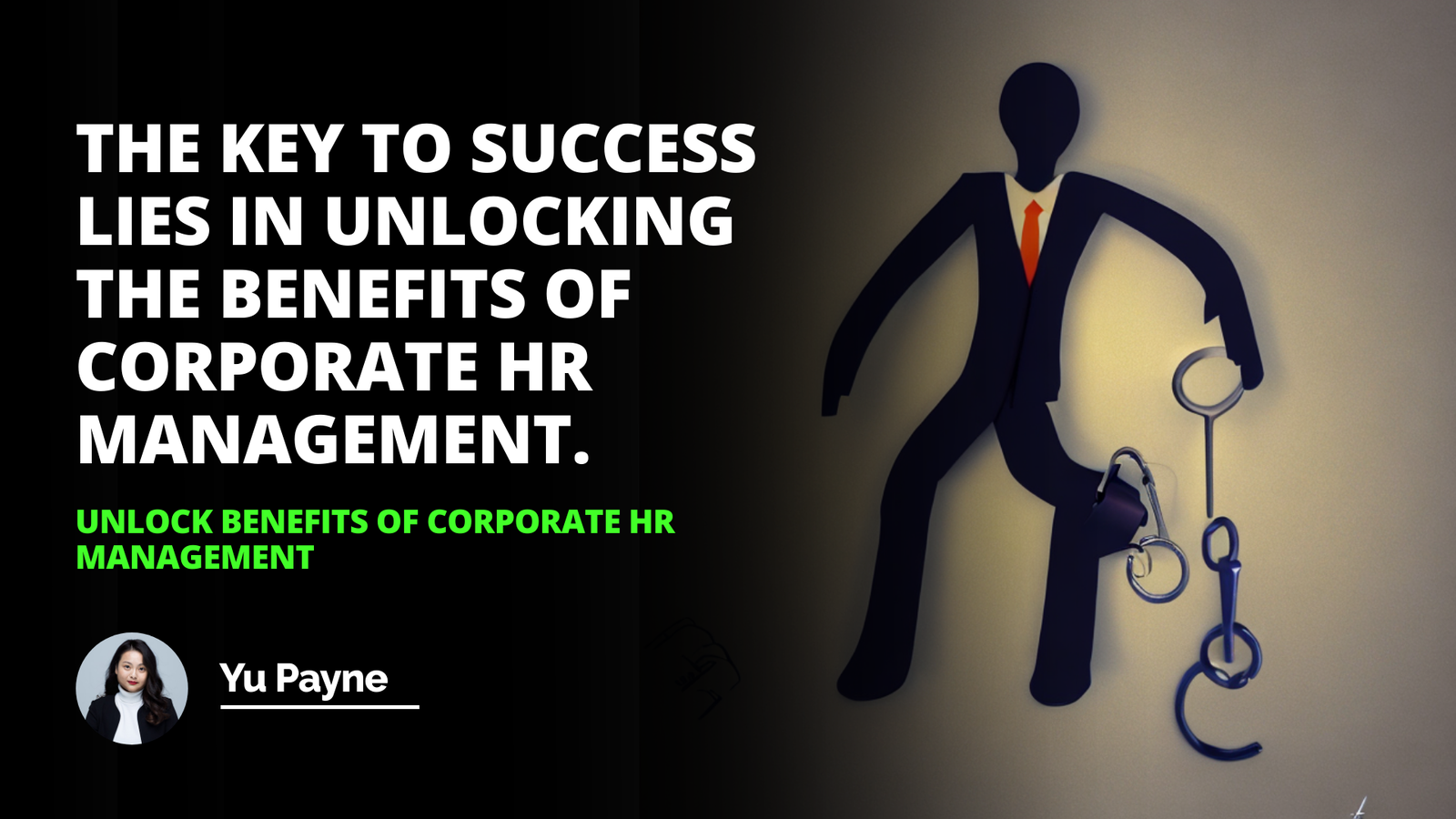
In any workplace, fostering an environment in which employees feel heard and valued is fundamental for maintaining harmony and ensuring operational efficiency. Disputes or dissatisfaction can arise, and it is essential that an established method exists for addressing these concerns. Grievance procedures are integral in providing a formal avenue through which employee complaints can be managed and resolved.
This comprehensive study will delve into the importance of having a well-defined grievance procedure and explore the steps and elements that constitute an effective system for upholding employee rights.
Understanding the Grievance Procedure
At the core of labor management lies the grievance procedure, a systematic approach designed to address and resolve disputes between employees and employers. By definition, a grievance procedure is a hierarchal process through which an employee can raise a concern, complaint, or formal accusation, typically regarding the terms and conditions of employment or dissatisfaction with the work environment or relationships.
The purpose and need for grievance procedures stretch beyond just problem-solving. It serves as a critical communication channel that upholds employee rights while also protecting the interests of the employer. These procedures promote a culture where issues can be discussed openly and managed fairly, reinforcing trust within the organization.
Furthermore, the legal aspects and regulations concerning grievance procedures reflect the employment laws and standards set by governmental bodies. Employers are bound by national labor laws to provide a mechanism for grievances, which, in turn, protects both parties from legal conflicts that can arise from unsettled disputes.
Elements of a Grievance Procedure
Developing an effective grievance procedure involves understanding and mapping out the sequential steps that guide both employees and management through the grievance process. These steps are essential to ensure a structured and fair approach to dispute resolution, thereby maintaining industrial harmony.
Initial Complaint: It all starts with an initial complaint, where the employee brings forth an issue informally to their direct supervisor. This stage is critical as it allows for early resolution without the need to escalate matters further. A well-handled initial complaint can prevent additional stress and disruption within the workplace.
Formal Grievance: Should the issue remain unresolved, the procedure advances to a formal grievance. During this phase, the employee submits a written grievance to the higher management or the HR department. This formal acknowledgment initiates a more systematic investigation and underscores the severity of the matter.
Grievance Hearing: The next step is the grievance hearing, where the concerned employee and representatives from management come together to present their cases to a designated officer or committee. It offers a platform where all involved parties can openly discuss the issues at hand, and management can attain a clearer understanding.
Decision: Subsequently, a decision is made by the employer based on the merits of the case presented during the hearing. This decision, ideally, should be communicated in writing and include detailed reasoning to ensure transparency and minimize any further disputes.
Appeal: Finally, an appeal process must be included to provide the employee with the opportunity to contest the decision if they believe justice has not been served. An appeal keeps the procedure fair and balanced, offering a second chance for review, often by a party not previously involved in the process.
The role and responsibilities of each party involved, including the aggrieved employee, human resources, and management, must be clearly defined. It is crucial that these roles are understood by all parties to foster a sense of accountability and to ensure each step is conducted with due diligence and impartiality.
Implementing a Grievance Procedure
The creation and enactment of a grievance procedure require meticulous planning and strategic implementation. Key steps in setting up such a process involve drafting a clear and comprehensive policy, training staff members on its significance and details, and ensuring consistent application across the organization.
Communication stands as the bedrock upon which the effectiveness of any grievance procedure is established. Clear lines of communication aid in the prevention of complications and misunderstandings throughout the process.
Communication Strategies
Employing communication strategies that encourage openness and facilitate dialogue can lead to more effective resolution of grievances. This includes workshops, policy manuals, and regular department meetings to reinforce the procedure's logistics and significance.
Record Keeping
Integral to the grievance process is record keeping. Detailed records provide an audit trail for every grievance filed and serve as vital documentation in case of legal scrutiny or review. They also play a critical role in identifying trends and areas for policy improvement.
Part of implementing a robust procedure includes hr certification programs for management and HR staff. Education on handling grievance procedures equips those involved with the skills and knowledge needed to navigate complex employee cases professionally and in line with legal requirements.
Grievance Procedure Examples
An analysis of any mechanism is incomplete without real-world illustrations. By examining case studies of real-life scenarios, organizations can glean insights into the ways in which a well-structured grievance procedure can positively impact both employee and employer relationships.
Positive Outcomes
In cases where the grievance procedure is followed meticulously, positive outcomes often emerge. These can include improved communication, enhanced employee morale, and sometimes, innovative problem-solving ideas that benefit the company as a whole.
Lessons Learned from Negative Outcomes
Even negative outcomes serve a purpose by providing valuable lessons. A grievance mishandled can serve as a stark reminder of the importance of a well-functioning system and the repercussions of neglecting employee voices.
The impact and importance of following a proper procedure cannot be overstated. It has the power to not only resolve individual grievances but also to prevent systemic issues from taking root within an organization's culture.
Potential Challenges and Solutions
No system is without its challenges, and grievance procedures are subject to a myriad of potential roadblocks. Common challenges include reluctance from employees to come forward, fear of retaliation, and, at times, management’s failure to take grievances seriously.
Addressing these challenges calls for proactive solutions, such as anonymized reporting options, establishing a culture of non-retaliation, and reinforcing the role of HR as a neutral party in disputes.
A comprehensive understanding and implementation of a grievance procedure is crucial for maintaining a harmonious workplace. It not only protects employee rights but also upholds the integrity of the organization. As we've explored, the various stages from initial complaint to appeal are instrumental in achieving resolution and ensuring justice is served.
Encouragement of proper implementation and continuous improvement of these procedures can transform potential conflicts into opportunities for growth and understanding within an organization.
Frequently Asked Questions
What is the influence of an effective grievance procedure on employee morale and productivity?
Understanding Grievance Procedures
A grievance procedure matters much in a workplace. It offers a formal route for workers to voice concerns. Good grievance mechanisms maintain order. They follow defined steps for issue resolution.
Employee Morale and Grievance Procedures
High morale often links to an efficient grievance process. Workers feel heard and valued when concerns receive attention. Trust in management generates from fair treatment. Morale soars when employees believe in fair processes.
Morale Boosts
- Empowerment: Employees voice opinions.
- Safety: Workers feel secure.
- Validation: Concerns receive proper attention.
Productivity and Grievance Procedures
Productivity ties closely to employee happiness. Happy workers tend to produce more. They show greater commitment. A reliable grievance process thus bolsters productivity.
Productivity Gains
- Focus: Less time on conflict.
- Purpose: Common organizational goals become clear.
- Engagement: Employees stay more involved.
A Balance of Factors
An effective grievance procedure influences many factors. It shapes culture, affects relationships, and determines focus. A balanced approach is crucial for positive outcomes. It's a dance of psychological safety and operational efficiency.
Balancing Act
- Psychological Safety: A base for employee expression.
- Efficiency: Keeps the business on track.
- Culture: Defines acceptable behaviors.
The Role of Management
Management plays a key role. Leaders enact and support grievance processes. Their active role shows they care. They mediate and facilitate resolutions.
Management Functions
- Enactment: Leaders create fair policies.
- Support: They back the process actively.
- Mediation: They ensure impartial resolution.
An effective grievance procedure is a power tool. It affects morale and productivity deeply. It touches nearly every aspect of work life. A company thrives when its people do. Employees feel respected and valued. Consequently, they work better and stay loyal. This all hinges on effective grievance handling.

How does a sound grievance procedure safeguard the rights of employees within an organization?
Importance of Sound Grievance Procedures
Promoting Fairness and Transparency
A sound grievance procedure for employees is crucial. It upholds justice within an organization. A well-established process ensures everyone receives fair treatment. All workers know their concerns matter. This transparency fosters trust. Trust between employees and management strengthens.
Safeguarding Employee Rights
Employees have rights. These rights require protection. A good grievance procedure does this. It outlines steps to address concerns. It does so without fear of retaliation. Employees feel secure. They know they can speak up. Their voices count. Their issues receive attention.
Ensuring Consistency
Consistency is vital. A uniform process provides this. Each case gets similar handling. No bias influences outcomes. Standards apply equally to all. Employees see the process as fair. They respect the procedures. They rely on the system.
Enhancing Communication
Communication is key. Grievance procedures facilitate this. They encourage dialogue between parties. Employers and employees talk. They seek understanding. They work to resolve problems. Improved communication leads to better relationships. It promotes a positive work environment.
Encouraging Swift Resolution
Efficient problem-solving matters. A sound process provides a swift resolution. Delays diminish trust. Employees need timely responses. The procedure ensures speedy action. It lays out time frames for each step. Quick resolutions reduce workplace tension. They restore normalcy sooner.
Supporting Continuous Improvement
Organizations must evolve. A grievance procedure aids in this. It highlights systemic issues. It allows employers to address them. Sustainable improvements can follow. The workplace gets better. It becomes more responsive to staff needs. Continuous improvement benefits everyone.
Protecting the Organization
An organization needs defense too. Grievances can escalate. They can lead to legal action. A solid procedure mitigates this risk. It demonstrates the organization's commitment to fairness. It helps defend against unwarranted claims. It protects the organization's reputation.
Effective grievance procedures are essential. They uphold employees' rights. They ensure fairness, consistency, and clear communication. They promote swift resolution of issues. Organizations benefit as well. They grow and protect themselves from legal risk. Everyone gains when grievance procedures work as they should.

What are the critical elements that should be incorporated into a grievance procedure to ensure comprehensive adherence to employee rights?
Introduction to Grievance Procedures and Employee Rights
Grievance procedures play a critical role. They ensure fair treatment. They also respect employee rights. Adequate procedures address workplace concerns effectively. They provide recourse for employees. This fosters a transparent work environment. It leads to improved employee relations.
Key Elements of Effective Grievance Procedures
Clarity and Accessibility
A grievance procedure must be clear. Workers should understand it easily. They need to know their rights. They should also know how to raise concerns. Thus, clear documentation is essential. It ensures employees understand the process.
- Clear language use
- Easy access to procedure documents
- Well-defined steps
Non-Retaliation Guarantees
Protection against retaliation is vital. It encourages reporting of grievances without fear. Employees feel safe to express concerns.
- Assurance against retribution
- Confidence for employees to come forward
Consistency
Consistency ensures fairness. All grievances warrant equal attention. This policy must be uniform. Treat all employees the same.
- Standardized treatment for each case
- Similar sanctions for similar grievances
Timeliness
Swift action on grievances matters. Delays discourage trust in the system. Resolve issues promptly. This builds confidence in the process.
- Defined time frames for resolution
- Prompt action on complaint receipt
Confidentiality
Confidential handling of grievances is key. This respects employee privacy. It also prevents workplace gossip.
- Secure information management
- Private discussions about sensitive matters
Impartiality
An impartial investigation is crucial. The procedure must provide an unbiased review. This ensures equitable treatment.
- Objective handling by appointed officials
- Avoiding conflicts of interest
Representation
Employees should have the right to representation. This can mean a colleague or a union representative. It supports fair hearings.
- Choice of personal representation
- Support during the grievance process
Record-Keeping
Maintain comprehensive records of grievances. This enables review and improvement. It also provides a history for reference.
- Detailed records of all cases
- Documentation of outcomes and steps taken
Feedback Loop
Implement a feedback mechanism. This allows for continuous improvement. Employees can suggest changes to the procedure.
- Collection of employee feedback post-resolution
- Consideration of suggestions for procedure updates
Implementing Comprehensive Grievance Procedures
Develop and communicate effectively. Train managers in the process. Ensure all employees are aware. Align procedures with laws and best practices.
- Training for responsible personnel
- Wide dissemination of procedure knowledge
- Alignment with legal requirements
Conclusion: Ensuring Employee Rights Through Grievance Procedures
A robust grievance procedure is essential. It enforces employee rights. It guarantees a fair, effective platform for workplace issues. Such a framework not only empowers employees. It also strengthens the organization’s ethical foundation. Implement these elements with care. Monitor and refine regularly. This approach ensures comprehensive adherence to employee rights.



